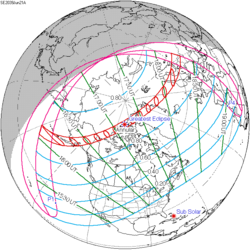| Total eclipse | |
 | |
| Gamma | 0.3518 |
|---|---|
| Magnitude | 1.0213 |
| Maximum eclipse | |
| Duration | 130 s (2 min 10 s) |
| Coordinates | 8°24′N113°12′E / 8.4°N 113.2°E |
| Max. width of band | 78 km (48 mi) |
| Times (UTC) | |
| Greatest eclipse | 4:33:30 |
| References | |
| Saros | 143 (22 of 72) |
| Catalog # (SE5000) | 9498 |
A total solar eclipse occurred at the Moon's ascending node of orbit on Tuesday, October 24, 1995, [1] with a magnitude of 1.0213. A solar eclipse occurs when the Moon passes between Earth and the Sun, thereby totally or partly obscuring the image of the Sun for a viewer on Earth. A total solar eclipse occurs when the Moon's apparent diameter is larger than the Sun's, blocking all direct sunlight, turning day into darkness. Totality occurs in a narrow path across Earth's surface, with the partial solar eclipse visible over a surrounding region thousands of kilometres wide. Occurring about 2.7 days before perigee (on October 26, 1995, at 21:00 UTC), the Moon's apparent diameter was larger. [2]
Contents
- Observation
- India
- China
- List of major cities in the path of totality
- In popular culture
- Images
- Eclipse details
- Eclipse season
- Related eclipses
- Eclipses in 1995
- Metonic
- Tzolkinex
- Half-Saros
- Tritos
- Solar Saros 143
- Inex
- Triad
- Solar eclipses of 1993–1996
- Saros 143
- Metonic series
- Tritos series
- Inex series
- Notes
- References
The path of totality went through Iran, Afghanistan, Pakistan, India, southwestern tip of Bangladesh, Burma, Thailand, Cambodia, Vietnam, Spratly Islands, northeastern tip of Sabah of Malaysia, Philippines and Indonesia. A partial eclipse was visible for parts of Northeast Africa, Asia, Australia, and northern Oceania.










































































































